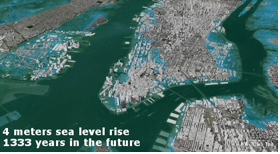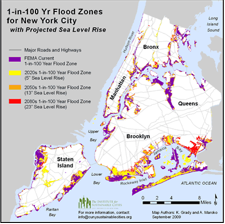 Sea level rise on the East Coast is accelerating at a rate much faster compared to the rest of the world. After analyzing tide levels data from North America, scientists have unexpectedly found that there is a 1,000 km-long sea-level rise (SLR) hotspot on the highly populated Eastern coast of North America.
Sea level rise on the East Coast is accelerating at a rate much faster compared to the rest of the world. After analyzing tide levels data from North America, scientists have unexpectedly found that there is a 1,000 km-long sea-level rise (SLR) hotspot on the highly populated Eastern coast of North America.
The hot spot stretches from Cape Hatteras, North Carolina, to the Boston area and continues to climb by about 2 to 3.8 millimeters a years- roughly 3-4 times higher than the global average.
Contrary to popular belief the global sea level is not rising at a consistent rate. The variations are the result of dynamic processes, which arise from circulation and variations in temperature and salinity, disruptions in Earth’s changing gravity, rotation and shape.
Sea levels are expected to rise as global warming continues to intensify, melting polar ice caps. As global temperatures continue to rise, the ocean absorbs the majority of the heat, resulting in the expansion of oceanic water.
Over 141,000 New York citizens are currently living within three feet of high tide- the same amount of sea level that will rise by 2100. It has also been reported that land 3.3 feet below sea level will one day be permanently underwater, this could occur within 100 years.
It is the potential of storms that should really have New Yorkers worried. The NY metro area hosts the nations highest density population that is vulnerable to the sea level rise.
It doesn’t help that the NY harbor is a funnel shade that would only help to magnify a storm surge.
Our homes and infrastructure are often built to withstand a “hundred-year storm”- a storm with such magnitude that there is a one percent chance it would occur in any given year. But what will happen to our built environment when 100-year storms begin to occur every 10 year and a 10-year storm is a regular event? We as green contractors need to start looking into the quality and longevity of our buildings today in order to better prepare clients and ourselves for the future.
In addition to strengthening our structures we may need to reassess where we are building.
As the likelihood of flooding and storm surges increases, we are beginning to be forced to reevaluate where we live. Much of New York City is just 16 feet above the mean sea level; some parts of Manhattan are only five feet above sea level! Some scientists are suggesting a drastic approach to future development of New York City: move the majority of people to high-lying areas and leaving the low-lying area as parks and buffer zones.
But there is hope! New York is among the best prepared cities in the country.
Last year, Mayor Michael Bloomberg announced that he was donated 50 million to The Sierra Club, the nations largest environmental ground for their “Beyond Coal” campaign. Their campaign aims to halt the opening of coal plants which are responsible for about 20% of global carbon emissions.
“Planning for climate change today is less expensive than rebuilding an entire network after a catastrophe,” said Mayor Bloomberg in a release in 2009.
It seems that the definition of “sustainable” is a continuously changing; building for the future not only means creating a build environment with longevity but building an environment that can withstand the power of nature.
Here is a link which shoes how your area will be affected my rising sea levels.
